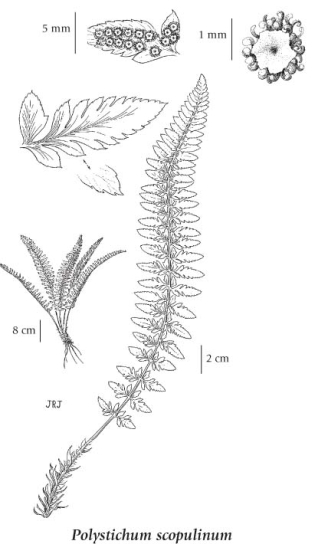Polystichum scopulinum (D.C. Eaton) Maxon
mountain holly fern (mountain hollyfern)
Dryopteridaceae (Wood Fern family)
Introduction to Vascular Plants
mountain holly fern (mountain hollyfern)
Dryopteridaceae (Wood Fern family)
Introduction to Vascular Plants
Species Information
General:
Evergreen perennial arising from a short, stout rhizome.
Leaves:
Lanceolate, 10-40 cm long, 3-7 cm wide, 1-pinnate, with stipe longer than 1/3 of the blade; pinnae oblong, arranged in plane of blade, deeply cut, with spreading teeth.
Illustration

If more than one illustration is available for a species (e.g., separate illustrations were provided for two subspecies) then links to the separate images will be provided below. Note that individual subspecies or varietal illustrations are not always available.
Illustration Source: The Illustrated Flora of British Columbia
Ecology
Ecological Framework for Polystichum scopulinum
The table below shows the species-specific information calculated from
original data (BEC database) provided by the BC Ministry of Forests and Range.
(Updated August, 2013)
The table below shows the species-specific information calculated from
original data (BEC database) provided by the BC Ministry of Forests and Range.
(Updated August, 2013)
| Site Information |
Value / Class |
||
|
Avg |
Min |
Max |
|
| Elevation
(metres) |
1620 | 1114 | 1857 |
| Slope
Gradient (%) |
43 | 8 | 90 |
|
Aspect (degrees) |
22 | 0 | 346 |
| Soil
Moisture Regime (SMR) [0 - very xeric; 4 - mesic; 8 - hydric] |
3 | 1 | 6 |
| Modal
Nutrient Regime
Class |
C | ||
| #
of field plots species was recorded in: |
13 | ||
| Modal
BEC Zone Class |
ESSF | ||
|
All BEC Zones (# of stations/zone) species was recorded in |
ESSF(11), ICH(2) | ||
|
Source:
Klinkenberg 2013
|
|||
Habitat and Range
Dry to mesic, shady, ultramafic rock outcrops of the montane zone; rare in SC BC, known only from the Tulameen River valley; disjunct E to PQ and S to CO, AZ, and CA.Status Information
| Origin Status | Provincial Status | BC List (Red Blue List) | COSEWIC |
|---|---|---|---|
| Native | S1S2 | Red | T (May 2005) |
BC Ministry of Environment: BC Species and Ecosystems Explorer.
Synonyms
Synonyms and Alternate Names:
Polystichum mohrioides var. scopulinum (D.C. Eaton) Fernald
Similar Species
Polystichum lemmonii and Polystichum kruckebergii are related taxa which are morphologically and ecologically similar to Polystichum scopulinum. P. scopulinum can be distinguished from P. lemmonii by its spiny-toothed pinna margins and its once pinnate fronds (vs. smooth margins and bipinnate fronds in P. lemmonii) (Douglas et al. 2000). P. kruckebergii has once pinnate fronds like P. scopulinum, but the pinnae are abruptly pointed (especially at the base of the frond) and bear coarse, spreading teeth. P. scopulinum has pinna tips that are obtuse and bear fine incurved teeth.
Source: British Columbia Conservation Data Centre |